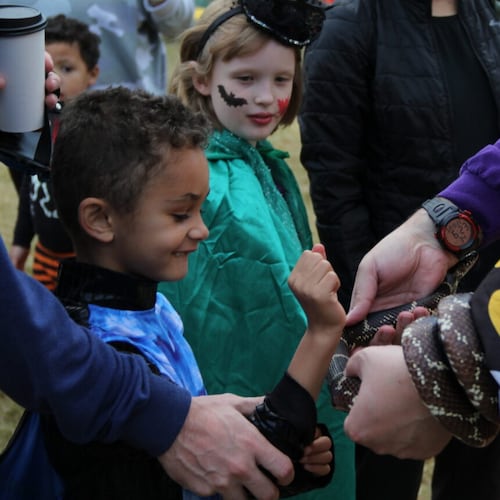Flying Colors Butterfly Festival at Chattahoochee Nature Center
This weekend’s event includes a chance to see butterflies up close, shop for butterfly-approved plants, make butterfly crafts, participate in the Butterfly and Caterpillar Costume Parade at the end of each day, listen to rootsy music, shop at a marketplace and dine from a food truck.
Live butterfly releases are planned for 11 a.m. and 1:30 p.m. July 13, 1:30 and 3:30 p.m. July 14. Opening this weekend, Butterfly Encounter, a 400-square-foot walk-through exhibit offers contact with more than 200 free-flying butterflies (continues through July 31).
Festival details: 10 a.m.-3 p.m. July 13, noon-5 p.m. July 14. $12. 9135 Willeo Road, Roswell. 770-992-2055, www.chattnaturecenter.org.
Dunwoody Nature Center’s Butterfly Festival
Two tents will boast more than 200 butterflies. Also: games, crafts, animal encounters and discovery stations throughout Dunwoody Park.
Festival details: 10 a.m.-4 p.m. Aug. 17. Advance tickets: $8, $4 ages 4-12. Day-of tickets: $10, $5 ages 4-12. 5343 Roberts Drive, Dunwoody. 770-394-3322, www.dunwoodynature.org.
Butterflies attract eyes with their ethereal flitting, here then gone.
Hundreds of metro Atlantans will try to draw closer to them during this weekend’s Flying Colors Butterfly Festival at Roswell’s Chattahoochee Nature Center and then at the Dunwoody Nature Center’s Butterfly Festival in mid-August.
But butterfly encounters needn’t be fleeting. Henning von Schmeling, Chattahoochee Nature Center operations senior director, shares five tips for inviting them into your garden.
1. Create a wild patch: Even if you live in a subdivision with tough covenants requiring a groomed yard, von Schmeling suggests dedicating a spot out back that is allowed to grow naturally. Butterflies are repelled, and often endangered, by herbicides and pesticides, he said. But they will find their way into overgrown areas, especially if you add flowers and plants that offer nectar or a place to lay their eggs.
2. Flowers will attract butterflies but other plantings will encourage them to multiply: "Everybody always hears that you have to plant flowers and flowers and more flowers because adult butterflies eat their nectar," von Schmeling said. "But you won't raise butterflies unless you have the specific host plants that adults need to lay their eggs on."
For instance, Georgia’s state butterfly, the tiger swallowtail, will look for its preferred host plant for laying eggs, tulip poplar trees, in your yard or nearby. Showy monarchs are in search of milkweed for the same purpose during spring and fall migration through the metro area.
3. Don't limit food offerings to nectar: Not all butterflies are into flower power. Multiple species of brush-footed butterflies, for instance, are attracted to rotting fruit, especially cut apples. Some even enjoy feeding on a rotting animal, so there may be a practical use for that squirrel that didn't quite make it across your busy street.
4. Check out a field guide: Von Schmeling recommends "Butterflies of Georgia" (Adventure Publications; $17.95), a 2004 paperback, by Jaret C. Daniels of the University of Florida's McGuire Center for Lepidoptera & Biodiversity. It features large color photographs of each butterfly plus an illustration that points out key identification marks. Information it details includes flight season, food plantings and distribution in the state.
5. Approach with caution: Kids in particular love interacting with butterflies. Putting some sugar water or bug juice on a finger is a well-known trick to attract the insects, but more important, von Schmeling said, is moving slowly.
“Their eyes are designed to see rapid shadow movement, and that usually indicates a predator. They can’t discern us fully as humans. For them, it looks more like, ‘Here’s this big block coming toward us’, which means they’re going to fly away. If you are cautious in coming up to them, you’re more likely to get them to stay close by.”
Given how delicate butterfly wings are, he suggested making it a game for kids to get as close as they can to the butterflies without touching them, but near enough to encourage observation.
“Just enjoy them with your eyes,” he suggested.
About the Author
Keep Reading
The Latest
Featured

